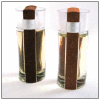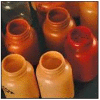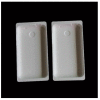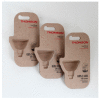Green Composites Made of Bamboo Fabric and Poly (Lactic) Acid for Packaging Applications-A Review
- PMID: 28773558
- PMCID: PMC5456759
- DOI: 10.3390/ma9060435
Green Composites Made of Bamboo Fabric and Poly (Lactic) Acid for Packaging Applications-A Review
Abstract
Petroleum based thermoplastics are widely used in a range of applications, particularly in packaging. However, their usage has resulted in soaring pollutant emissions. Thus, researchers have been driven to seek environmentally friendly alternative packaging materials which are recyclable as well as biodegradable. Due to the excellent mechanical properties of natural fibres, they have been extensively used to reinforce biopolymers to produce biodegradable composites. A detailed understanding of the properties of such composite materials is vital for assessing their applicability to various products. The present review discusses several functional properties related to packaging applications in order to explore the potential of bamboo fibre fabric-poly (lactic) acid composites for packaging applications. Physical properties, heat deflection temperature, impact resistance, recyclability and biodegradability are important functional properties of packaging materials. In this review, we will also comprehensively discuss the chronological events and applications of natural fibre biopolymer composites.
Keywords: bamboo fabric; biopolymer; functional properties; natural fibre; packaging applications; poly (lactic) acid; woven fabric.
Conflict of interest statement
The authors declare no conflict of interest.
Figures



















References
-
- Dicker M.P.M., Duckworth P.F., Baker A.B., Francois G., Hazzard M.K., Weaver P.M. Green composites: A review of material attributes and complementary applications. Compos. Part A Appl. Sci. Manuf. 2014;56:280–289. doi: 10.1016/j.compositesa.2013.10.014. - DOI
-
- La Mantia F.P., Morreale M. Green composites: A brief review. Compos. Part A Appl. Sci. Manuf. 2011;42:579–588. doi: 10.1016/j.compositesa.2011.01.017. - DOI
-
- Abdul Khalil H.P.S., Bhat A.H., Ireana Yusra A.F. Green composites from sustainable cellulose nanofibrils: A review. Carbohydr. Polym. 2012;87:963–979. doi: 10.1016/j.carbpol.2011.08.078. - DOI
-
- Mukherjee T., Kao N. PLA based biopolymer reinforced with natural fibre: A review. J. Polym. Environ. 2011;19:714–725. doi: 10.1007/s10924-011-0320-6. - DOI
-
- Lee J.T., Kim M.W., Song Y.S., Kang T.J., Youn J.R. Mechanical properties of denim fabric reinforced poly(lactic acid) Fibers Polym. 2010;11:60–66. doi: 10.1007/s12221-010-0060-6. - DOI
Publication types
LinkOut - more resources
Full Text Sources
Other Literature Sources

